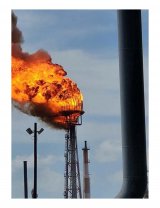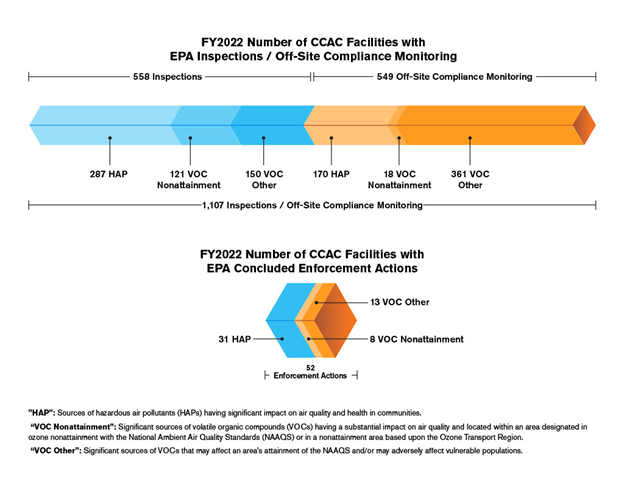National Enforcement and Compliance Initiative: Creating Cleaner Air for Communities by Reducing Excess Emissions of Harmful Pollutants
Problem

People living in non-attainment areas or in communities that are near sources of hazardous air pollutants (HAPs) may face significant risks to their health and environment. Nonattainment is any area in the United States that does not meet the primary or secondary national ambient air quality standards (NAAQS).
HAPs are pollutants that are known or suspected to cause cancer or other serious health effects. In some instances, small amounts of these chemicals inhaled or ingested can cause serious illness. EPA has identified over 180 chemicals as HAPs, including mercury, benzene, dioxin, ethylene oxide, and lead compounds.
In addition to HAPs, significant sources of volatile organic compounds (VOCs) contribute to non-attainment with the NAAQS or may adversely affect the attainment status of an area. VOCs are a key component in the formation of ground-level ozone, which creates smog, and secondary organic aerosols, which may impact ecosystems and can cause adverse health effects in people.
Goal
The Creating Clean Air for Communities (CCAC) National Enforcement and Compliance Initiative (NECI), initiated in fiscal year 2020, was designed to address the adverse health and environmental effects from sources of toxic air pollution and help improve air quality in communities across the country. Implementing this NECI has resulted in the installation of new pollution controls as well as the proper operation of existing controls at numerous facilities resulting in significant reductions of toxic pollutants, as well as methane and other greenhouse gases, which contribute to climate change.
Results
During FY 2023, the Agency continued to make significant progress on this NECI. The following summary illustrates the Agency’s efforts in FY 2023 to improve air quality and reduce excess emissions of VOCs and HAPs:
-
Pollutant Reduction
- EPA addressed serious violations through enforcement actions, achieving measurable pollutant reductions and improving air quality to provide cleaner air for communities. FY 2023 enforcement actions alone have resulted in a reduction of approximately 30 million pounds of VOCs and HAPs as well as other harmful air pollutants. FY 2023 enforcement actions also resulted in the reduction of over 307 million pounds of carbon dioxide equivalent (CO2e), including methane.
- EPA addressed serious violations through enforcement actions, achieving measurable pollutant reductions and improving air quality to provide cleaner air for communities. FY 2023 enforcement actions alone have resulted in a reduction of approximately 30 million pounds of VOCs and HAPs as well as other harmful air pollutants. FY 2023 enforcement actions also resulted in the reduction of over 307 million pounds of carbon dioxide equivalent (CO2e), including methane.
-
Cases
-
Oversight of Emergency Orders
- Significant EPA oversight of previously issued CAA § 303 emergency orders is ongoing to address imminent and substantial endangerment to public health and the environment in St. Croix and in South Carolina. EPA took additional enforcement as appropriate in FY 2023 to help ensure cleaner air for these communities.
- Significant EPA oversight of previously issued CAA § 303 emergency orders is ongoing to address imminent and substantial endangerment to public health and the environment in St. Croix and in South Carolina. EPA took additional enforcement as appropriate in FY 2023 to help ensure cleaner air for these communities.
-
Examples of concluded enforcement actions in FY 2023 include the following:
-
FY 2023 Number of CCAC Facilities with EPA Inspections / Off-site Compliance Monitoring

-
Advanced, innovative equipment and techniques
- Employed infrared cameras using optical gas imaging and the National Enforcement Investigations Center’s geospatial measurement of air pollution (GMAP) vehicle during inspections. This technology allows for real time identification of VOC and HAP emissions, identifying potential noncompliance resulting from fugitive emissions and equipment leaks.
-
Enhanced use of compliance monitoring tools
-
Inclusion of a requirement for facilities to continually monitor concentrations of emissions along their property boundary (i.e. fenceline) in enforcement settlements, when appropriate, provides additional insight into emission sources and their potential impacts.
-
For petroleum refineries which are required to implement a fenceline monitoring program for benzene emissions, the Agency provides a Dashboard to make the publicly available data easier to access and analyze by EPA, state and other regulatory agencies, as well as members of the public.
-
-
Compliance Assistance Portal
- Through partnerships with state and tribal authorities, EPA regional offices conducted multiple joint inspections and joint enforcement actions, including Matador and Mewbourne.
- Through partnerships with state and tribal authorities, EPA regional offices conducted multiple joint inspections and joint enforcement actions, including Matador and Mewbourne.
-
Issued Compliance Advisories and Enforcement Alerts
-
In March 2023, EPA issued a federal facility compliance advisory to highlight the CCAC NECI alerting federal facilities of their responsibility to ensure compliance with all CAA regulatory requirements and to not release excess VOC or HAP emissions that cause significant harm to the public, including overburdened communities with potential environmental justice concerns. The EPA is highlighting this NECI for federal facilities so they may promptly address any noncompliance.
-
-
Compliance Assistance Portal
-
Enhanced the Environmental Compliance Information for Energy Extraction portal providing compliance assistance for owners and operators of crude oil and natural gas extraction operations.
-
